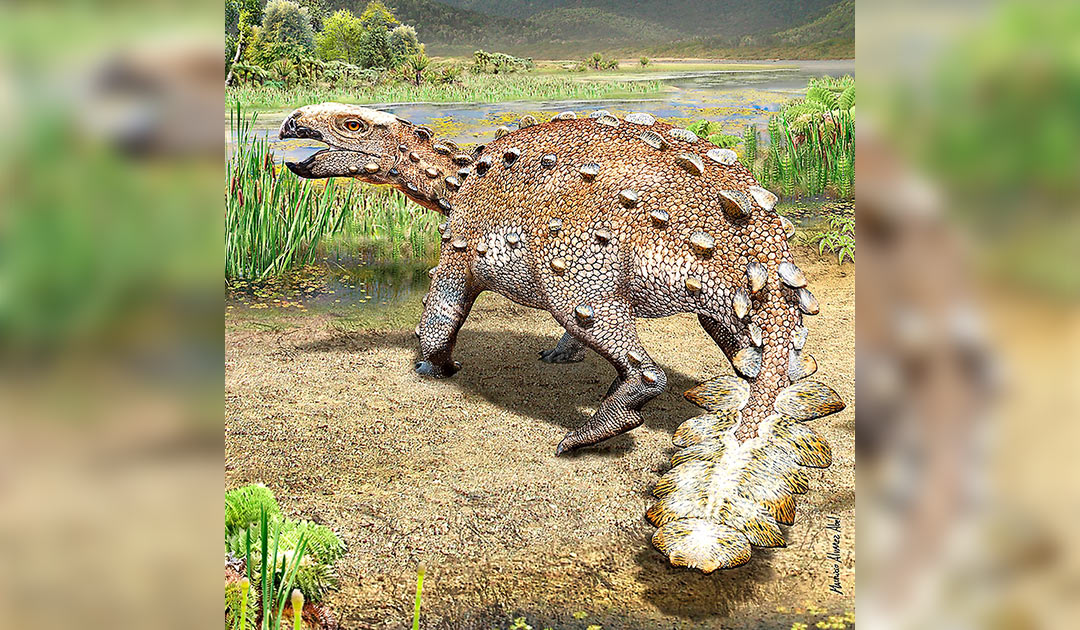
Chile is not exactly known for numerous dinosaur finds – at least not yet. The first species was described only ten years ago and since then only three others have been added. Most recently, in 2018, Chilean paleontologists found a very well-preserved and almost complete skeleton in Patagonia that could not be clearly assigned to any of the already known dinosaur species, mainly because of its bizarre “armed” tail. The scientists published the precise description of their spectacular find this week in the scientific journal Nature.
The paleontologists found the skeleton in the Magallanes region on a steep hill in the valley of the Río de las Chinas near the Torres del Paine National Park in rocks from the Cretaceous period. The 74-million-year-old skeleton was 80 percent complete. The remains of the dinosaur amazed scientists not only because of their good state of preservation, but especially because of the strange shape of the tail. Its back half consisted of seven pairs of laterally protruding skin bones resembling a fern frond or a macuahuitl, the feared war club of the Aztecs. Based on these unique features, the approximately two-meter-long dinosaur was clearly identified as a new species, which the researchers named Stegouros elengassen. Stegouros translates as “roof-shaped tail”, while elengassen is the name of a mythical armored monster in the tradition of the indigenous Aonik’enk people, also known as Patagonians or southern Tehuelche.

The features of Stegouros are reminiscent of both stegosaurs and ankylosaurs, as if it were a hybrid species. Alexander Vargas, a vertebrate paleontologist at the Faculty of Natural Sciences of the University of Chile in Santiago and leader of the study, describes that “the spectacular stegosaurs are among the best known dinosaurs, both for their famous vertical dorsal plates and for their paired barbed tail weapon. The advanced ankylosaurs, on the other hand, are famous for their broad, bone-armored backs and their huge, rounded club at the end of their tails. Our dinosaur’s tail weapon was clearly none of these things.”
Sergio Soto, who co-led the study with Vargas and is also a researcher at the University of Chile, adds that it is “an evolutionary link between ankylosaurs and other older lineages of armored dinosaurs. Stegouros exhibits only some of the features normally found in ankylosaurs, particularly on the skull, but lacks many others. It also exhibits some stegosaur-like features that it inherited from a common ancestor with the stegosaurs, but which were lost in other ankylosaurs during evolution.”
The scientists therefore compare their discovery with the “Rosetta Stone”. This find, they argue, allows them to understand the evolution of the few remains identified as ankylosaurs in the Southern Hemisphere.
According to the researchers, ankylosaurs are largely unknown in South America. So far, only a few bones and fragments of little significance have been found. The discovery of Stegouros therefore exceeded all expectations. In addition to identifying a new species, the scientists also discovered great similarities to two previous finds: Antarctopelta from Antarctica and Kunbarrasaurus from Australia. Stegouros thus provides much information about the ankylosaurs of the Southern Hemisphere and how they differ from their northern relatives. They tend to be smaller, have a lighter carapace, slimmer limbs and some of them also have the characteristic tail.
Because the differences from the already known ankylosaurs are so striking, the authors proposed in their study to call the dinosaurs that lived on the northern megacontinent Laurasia Euankylosaurs (“true ankylosaurs”) and those from the southern megacontinent Gondwana Parankylosaurs (“next to the ankylosaurs”). On the former Laurasia there are numerous fossils of ankylosaurs in great variety.

In addition, the discovery of stegouros showed that three completely different types of specialized tail weapons evolved independently: the paired spines of stegosaurs, the club of “modern” ankylosaurs, and the makuahuitl of stegouros. “Parankylosaurs lack many features of the “real” ankylosaurs, which were already present in the middle Jurassic, about 165 million years ago. Therefore, the roots of parankylosaurs must be very old, before that date,” Vargas said.
Julia Hager, PolarJournal
More on the subject:





